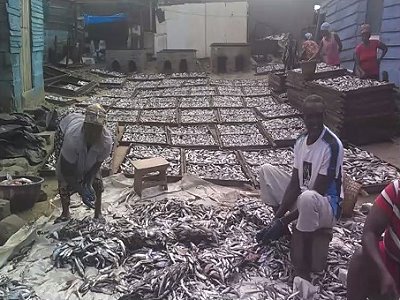Session 1 Ecology and harvesting
Speakers were: Santiago de la Puente, Institute for the Oceans and Fisheries, UBC, Vancouver, Canada; Francis K.E. Nunoo, University of Ghana; Jeppe Kolding, University of Bergen, Norway; and Martin Pastoors, Pelagic Freezer-trawler Association, Netherlands.
 Santiago de la Puente opened with vistas on the biggest global fishery targeting the Peruvian anchoveta (Engraulis ringens) where the top seven companies account for some 60% of the catch earning perhaps as much as US$ one billion each. The rest is caught by smaller vessels which employ almost 250,000 people. The overwhelming majority of the catches are reduced to fish meal and oil as feed e.g. for aquaculture in China and Europe and much of the added value accrues outside of Peru. In modern day Peru only a small percentage of the fish is used for direct human consumption even though the economic multipliers for fish for food are much more interesting than those for meal, but the promotional campaign stopped in 2012 and efforts to increase human consumption and consolidate multiple ways to make it available in human diets throughout the country and beyond and thus jobs and higher earnings than in the reduction industry faltered.
Santiago de la Puente opened with vistas on the biggest global fishery targeting the Peruvian anchoveta (Engraulis ringens) where the top seven companies account for some 60% of the catch earning perhaps as much as US$ one billion each. The rest is caught by smaller vessels which employ almost 250,000 people. The overwhelming majority of the catches are reduced to fish meal and oil as feed e.g. for aquaculture in China and Europe and much of the added value accrues outside of Peru. In modern day Peru only a small percentage of the fish is used for direct human consumption even though the economic multipliers for fish for food are much more interesting than those for meal, but the promotional campaign stopped in 2012 and efforts to increase human consumption and consolidate multiple ways to make it available in human diets throughout the country and beyond and thus jobs and higher earnings than in the reduction industry faltered.
Francis K.E. Nunoo gave a brief run down of the resource situation of small pelagic fish based on the Fridtjof Nansen survey in the Gulf of Guinea in 2016. These are Sardinella maderensis, S. aurita, anchovy (Engraulis encrasicolus), Atlantic chub mackerel (Scomber colias), Atlantic bumper (Chloroscombrus chrysurus), round scad (Decapterus punctatus) and moon fish (Selene dorsalis). He noted that while the legal mesh size of fishing nets was 25 mm, the use of nets with 10 mm mesh size was common and that despite - or probably because of - the smaller mesh sizes beach seines had very poor catches nowadays. Use of light and electric fishing was leading to the catch of many juveniles. According to the latest CECAF stock assessment steep decreases in catch per unit of effort pointed to severe overexploitation and the need to better management and resource recovery.
 Jeppe Kolding focused on inland water fish production in Africa which he said had increased by 3.5% per year according to FAO data, but was largely under-reported. He showed the energy transfer pyramid illustrating that only approximately 10% of the energy is passed from one trophic level to the next while most of the energy at each level is needed for maintaining life functions. In other words, zooplankton feeding on minute aquatic plants represent about 10% of the plant biomass and babies of large fish and fish remaining small throughout their lifetime represent about 10% of the biomass of zooplankton and so on. As bigger fish eat smaller ones, he argued in favour of reducing bigger fauna which could feed on small fish and rather catch small fish, including juveniles of big fish, to produce more food for poor people on the assumption that poor people should only eat small fish.
Jeppe Kolding focused on inland water fish production in Africa which he said had increased by 3.5% per year according to FAO data, but was largely under-reported. He showed the energy transfer pyramid illustrating that only approximately 10% of the energy is passed from one trophic level to the next while most of the energy at each level is needed for maintaining life functions. In other words, zooplankton feeding on minute aquatic plants represent about 10% of the plant biomass and babies of large fish and fish remaining small throughout their lifetime represent about 10% of the biomass of zooplankton and so on. As bigger fish eat smaller ones, he argued in favour of reducing bigger fauna which could feed on small fish and rather catch small fish, including juveniles of big fish, to produce more food for poor people on the assumption that poor people should only eat small fish.
Martin Pastoors reported that his company was catching small pelagics in the NE Atlantic, the South Pacific and off West Africa in the cheapest and most efficient way possible and was selling the frozen product in Africa and Asia.
The discussion focused a lot on the evolution of the fisheries and how a situation had arisen that most of the Peruvian anchoveta production - although food grade - was allowed to be reduced to fish meal while a good part of domestic consumption was from aquaculture and imports. It also touched on issues of environment management, social justice and distributional policies.








